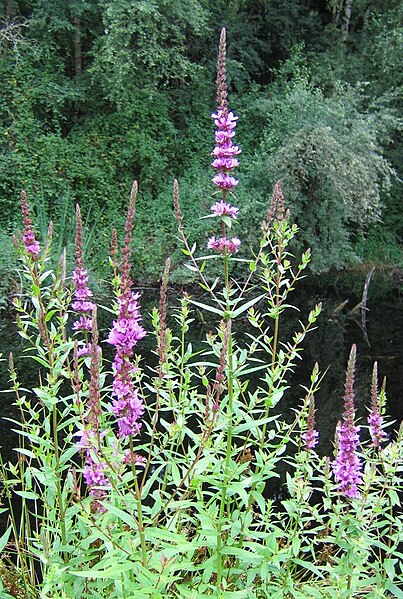Please welcome back Brandon Moyer with another entry on invasive species
The next species I would like to present to you in my exploration of invasive species is one that is notorious among biologists across the country. Though it is quite beautiful in bloom, it is known as a super invasive plant species that disrupts habitats and displaces many native species of fish as well as insects, birds, and other small mammals.
The species is Lythrum salicaria, and it may be something you see every day without even knowing it. It is known by over ten common names including spiked loosestrife and purple lythrum worldwide, but is best known by the name Purple Loosestrife in the United States. Purple Loosestrife was first introduced into North America through several different vectors; as an ornamental plant for ponds and gardens, as an herb used in cooking and medicine, and through ship ballast water. The origin of Purple Loosestrife is unknown, although its current range is vast. It is very hardy, has spread across Asia and Europe, only limited by the extreme cold of the upper northern hemisphere.
Purple Loosestrife spreads in two ways. One adult plant (4+ years of age) can produce over two million seeds in a single season. These seeds tend to float which aids in dispersal. Their rhizomes, commonly known as runners, can grow up to a foot a season. New plants can spring from these rhizomes, which compounds the number of seeds produced each season.
In several biology and ecology courses I had taken at Millersville University, L. salicaria was a popular example of an introduced species that has taken a strong foothold in a new environment. The dense clusters of roots and rhizomes choke out the roots of other plants around the loosestrife, increasing the area in which it can spread and smothering native plants. Their leaves decompose in the fall when the weather begins to cool and detritivore activity decreases, leading to nutrification of infested waterways. Its thick undergrowth deprives native animals like turtles of areas to bask, but is not dense enough to protect other animals from predation.
Today you can see purple loosestrife almost anywhere you see water in the eastern United States including bogs and drainage areas around warehouses and malls. It can be found in every state except for Florida, Hawaii, and Alaska. Conventional methods of eradicating the invasive, including herbicides and burning, are ineffective. One interesting method of control, considered biological control, is introducing other non-native species that prey on the invasive species. In the case of Purple Loosestrife, leaf beetles, root boring weevils, and flower and seed eating weevils have all been introduced to help stop the spread of the weed.
In any case, control is necessary to protect the complex ecosystems of the wetlands that Purple Loosestrife dominates. You can help by first learning to identify loosestrife, then using methods to control the spread of this invasive species if you find it on your property by digging, pulling, spot spraying or cutting the plants while they are in bloom and before they seed, usually June-Early August. Remove the plants and cuttings in plastic bags so they degrade, or incinerate the remains of the plants in a contained area. It is not recommended that they be composted. Also, avoid certain cultivars of garden loosestrife and their seed, though they may not be invasive varieties, many may be able to cross pollinate with the invasive species.
For more information on Loosestrife visit the following sites:
http://www.invasive.org/eastern/biocontrol/11PurpleLoosestrife.html
http://www.npwrc.usgs.gov/resource/plants/loosstrf/index.htm
http://dnr.wi.gov/invasiveS/fact/loose2.htm
http://www.seagrant.umn.edu/ais/purpleloosestrife_info
Image referenced from Wikipedia http://en.wikipedia.org/wiki/Image:Purple_loosestrife2.jpg, first posted by Megger and used under the GNU Free Documentation License
Thanks Brandon,
Until Next Time,
Dave
 Pond Plants, more than most other plants in my opinion (probably because they always have access to water) can really kick into growth once the water temperature goes up. I’ve been one of the folks who literally starts throwing away the water hyacinths I paid 4 bucks for a few months earlier because I have no where to go with them. I’ve seen the dwarf moneywort in my pond run out of room within and establish itself OUTSIDE the pond. Even hardy pond lillies, while beautiful, can go to town in a mud bottomed pond.
Pond Plants, more than most other plants in my opinion (probably because they always have access to water) can really kick into growth once the water temperature goes up. I’ve been one of the folks who literally starts throwing away the water hyacinths I paid 4 bucks for a few months earlier because I have no where to go with them. I’ve seen the dwarf moneywort in my pond run out of room within and establish itself OUTSIDE the pond. Even hardy pond lillies, while beautiful, can go to town in a mud bottomed pond.  That Fish Blog – Aquarium Advice and Information
That Fish Blog – Aquarium Advice and Information

